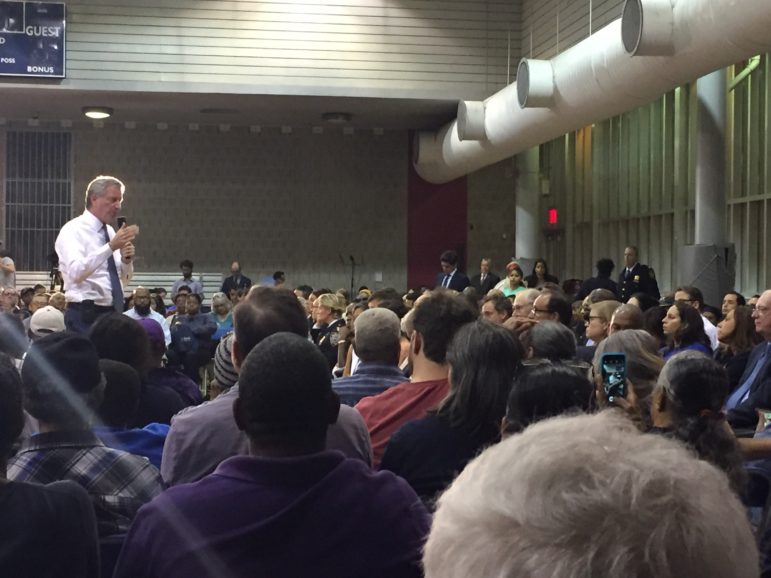
Abigail Savitch-Lew
The mayor speaks to constituents at an East Harlem town hall on Thursday September 28.
Residents of Spanish Harlem have a lot concerning them these days, from the disaster in Puerto Rico to Trump’s rescinding of DACA—to the potential impacts of the city’s proposed neighborhood rezoning. At a town hall on Thursday night, residents showed adamant opposition to the proposed rezoning, which the City Planning Commission is expected to vote on this Monday, but the mayor took issue with their concerns.
Beyond discussion of the rezoning, however, there was overall a deal of respect expressed for Mayor De Blasio at the town hall, and a good deal of gratitude for the accomplishments of three-term local councilmember and City Council Speaker Melissa Mark-Viverito, who has only a few months left on the job.
De Blasio took time at the beginning of the meeting to praise Mark-Viverito, saying the city would look back at her time in City Council as a “golden age” and heralding her work on tenant protections, affordable housing, criminal justice and safety, as well as her recent advocacy for Puerto Rico. The federal government’s lack of action to serve the island he described as “truly an atrocity” and he urged constituents to learn about how they could help.
Before opening the floor, de Blasio noted a number of small improvements he said were being undertaken immediately. New lights had been installed that day on the intersection of 125th Street and Park Avenue; improvements were being made to local small parks; the sidewalks of Johnson Houses would be fixed by the end of the year, and there would be new litter collections on key streets.
Constituents brought up a wide variety of problems—not enough licenses for street venders, a police officer perceived to have a disrespectful tone, a landlord’s illegal renovation work without a permit, for instance—and the mayor and his commissioners tried to deliver answers or a promise to follow-up.
Here are five of the most common issues raised by constituents:
NYCHA concerns
The town hall took place in Johnson Houses’ community center and drew a large number of NYCHA residents from the surrounding area. East Harlem has the highest concentration of NYCHA developments in the city, with nearly 30 percent of residents living in NYCHA, according to the East Harlem Neighborhood Plan.
Tenant leader Ethel Velez, noting the amount of money the mayor had dedicated to his affordable housing, asked for more money to preserve NYCHA’s dilapidated building stock. Others brought specific requests or concerns: Wagner Houses needs a bigger senior center. Polo Grounds is infested with raccoons and suffers from leaks and potholes. A neighbor is breaking NYCHA’s rule against the ownership of pitbulls. Others were concerned about rent increases and the rumored “privatization” of NYCHA.
Some residents were also reeling from a recent, unresolved death just one street away at Jefferson Houses. As reported by The Daily News, on August 19, 33-year-old Yanina Boitel, a mother of three and grandmother, was found dead after falling off the roof of her building. One Jefferson resident brought up concerns about safety and building cameras; later, a woman who appeared to be a close relative of Boitel said in near-tears that she didn’t believe it was a suicide. An NYPD official couldn’t speak to the details due to an ongoing investigation, but said that thanks to a heavy cop presence at Jefferson and Johnson Houses, shootings were down 50 percent for the year. The De Blasio team mentioned resources coming for new cameras.
As for the other concerns, De Blasio said that given the absence of sufficient federal funding, he’d put an unprecedented amount of city money into NYCHA repairs, including $1.3 billion in capital funds in just one year, and said the city would continue to, in each year, take more responsibility. He justified his commitment to creating new affordable housing, but promised that NYCHA “will never be privatized, I want to be 100 percent clear.”
He and NYCHA chair Shola Olatoye emphasized that when private entities like Goldman Sachs become investment partners in a NYCHA building—as in cases where the city is moving NYCHA buildings to the Rental Assistance Demonstration program—NYCHA still retains ownership of the land and control of important decisions. As for the rent increases, Olatoye says they were mandated by the federal government and in no case should make a resident pay more than 30 percent of their income.
They also made some commitments: to explore the location of a new senior center for Wagner Houses, to reexamine the regulations governing the removal of illegal pets, and—since residents were asking for it—to provide more stringent enforcement of trash rules through increased ticketing.
The rezoning
A group of Movement for Justice in El Barrio members protested the proposed rezoning outside the community center, and within the town hall there were a couple speeches condemning it—followed by resounding applause and chants. One resident said the market-rate housing brought by a rezoning would exacerbate displacement and accused De Blasio of catering to developers’ interests.
“You might disagree with me on the vision but don’t look for a motive that isn’t there,” said De Blasio, arguing that the plan would bring new, permanent affordable housing and was a once-in-a-generation opportunity to bring new investments to East Harlem. “I’m convinced that the market-rate housing is not going to change the trajectory of all neighborhoods.” He said NYCHA and rent-stabilized housing would remain protected—though many advocates are concerned the administration is underestimating the risks to rent-stabilized housing. Mark-Viverito spoke to the importance of a balance, and said she would work for the priorities of the neighborhood plan.
When another resident from the Justice Center in El Barrio said that none of the mandated new housing would be truly affordable to the lowest incomes and condemned the mayor for selling land to private developers, De Blasio dismissed her concerns and wouldn’t go further into it. According to The Post , a nearby resident shouted “Bull shit!”, Mark-Viverito defended the mayor, and soon after security guards escorted a group of residents out as they chanted “no rezoning.”
Trouble in the schools
Showing his deep concern about the recent stabbing death of a student in a Bronx high school, De Blasio began the evening with a moment of silence for 15-year-old Matthew McCree. The Times has reported that the student charged with murder may have reacted in response to bullying. Several residents called for deeper interventions to stem violence and provide more city services for youth.
In addition, a charter school student asked whether de Blasio would support lifting the cap on charter schools, and a parent complained of lack of space in a building with three co-located schools.
De Blasio pointed to the administration’s growing investment in the CureViolence model, which seeks to reduce violence through peer-to-peer conflict resolution, his investments in school counseling, the city’s new mental illness program Thrive NYC, and in creating an after-school seat for every middle schooler who wants one. He promised to continue improving public schools but said he didn’t think the cap on charters should be removed.
New and old worries at HDFCs
Housing Development Fund Corporations (HDFCs), or low-income cooperatives, provide some of the city’s most affordable homeownership opportunities, but some HDFCs face problems, including worsening building conditions, financial mismanagement, or increasingly loss of affordability.
A couple speakers raised concerns with the city’s potential foreclosure of 84 HDFCs and plan to transfer the HDFCs, which are in debt to the city, to third-party owners that will stabilize and rehabilitate the buildings and make the shareholders tenants. De Blasio’s team, while justifying the measure, said that buildings willing to get on a payment plan and avoid foreclosure could come see the Commissioner of Housing Preservation and Development (HPD) immediately.
A plan for homelessness
At least two residents raised concerns about the homelessness crisis, with one saying that hundreds of people were leaving the shelter on Randall and Ward’s Island and entering East Harlem because they had nowhere else to go, while many patients of the methadone clinics on 125th Street were hanging out on the street. A member of Picture the Homeless asked for, and still couldn’t get, a position from the mayor on the Housing Not Warehousing Act.
De Blasio’s Human Resources Commissioner Steven Banks announced that the administration had stopped requiring homeless people to leave their shelters during the day and now were encouraging residents to take part in employment programs at their shelter. De Blasio acknowledged the crisis but also defended his approach to homelessness, pointing to his investments in eviction-prevention, a rent freeze, and in rental assistance to move families out of homeless shelters, among other efforts.









One thought on “A Healthy Dialogue, Except on Rezoning, at East Harlem Town Hall”
Allowing citibikes to take needed parking spaces is totally unfair and costly to the drivers in poor neighborhoods!